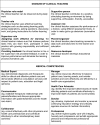Assessing the quality of clinical teachers: a systematic review of content and quality of questionnaires for assessing clinical teachers
- PMID: 20703952
- PMCID: PMC2988147
- DOI: 10.1007/s11606-010-1458-y
Assessing the quality of clinical teachers: a systematic review of content and quality of questionnaires for assessing clinical teachers
Abstract
Background: Learning in a clinical environment differs from formal educational settings and provides specific challenges for clinicians who are teachers. Instruments that reflect these challenges are needed to identify the strengths and weaknesses of clinical teachers.
Objective: To systematically review the content, validity, and aims of questionnaires used to assess clinical teachers.
Data sources: MEDLINE, EMBASE, PsycINFO and ERIC from 1976 up to March 2010.
Review methods: The searches revealed 54 papers on 32 instruments. Data from these papers were documented by independent researchers, using a structured format that included content of the instrument, validation methods, aims of the instrument, and its setting.
Results: Aspects covered by the instruments predominantly concerned the use of teaching strategies (included in 30 instruments), supporter role (29), role modeling (27), and feedback (26). Providing opportunities for clinical learning activities was included in 13 instruments. Most studies referred to literature on good clinical teaching, although they failed to provide a clear description of what constitutes a good clinical teacher. Instrument length varied from 1 to 58 items. Except for two instruments, all had to be completed by clerks/residents. Instruments served to provide formative feedback ( instruments) but were also used for resource allocation, promotion, and annual performance review (14 instruments). All but two studies reported on internal consistency and/or reliability; other aspects of validity were examined less frequently.
Conclusions: No instrument covered all relevant aspects of clinical teaching comprehensively. Validation of the instruments was often limited to assessment of internal consistency and reliability. Available instruments for assessing clinical teachers should be used carefully, especially for consequential decisions. There is a need for more valid comprehensive instruments.
Conflict of interest statement
None disclosed.
Figures
Comment in
-
Understanding clinical teachers: looking beyond assessment scores.J Gen Intern Med. 2010 Dec;25(12):1268-9. doi: 10.1007/s11606-010-1479-6. J Gen Intern Med. 2010. PMID: 20700664 Free PMC article. No abstract available.
-
Assessing the quality of clinical teachers.J Gen Intern Med. 2011 Jan;26(1):14; author reply 15. doi: 10.1007/s11606-010-1545-0. J Gen Intern Med. 2011. PMID: 20967506 Free PMC article. No abstract available.
Similar articles
-
Health professionals' experience of teamwork education in acute hospital settings: a systematic review of qualitative literature.JBI Database System Rev Implement Rep. 2016 Apr;14(4):96-137. doi: 10.11124/JBISRIR-2016-1843. JBI Database System Rev Implement Rep. 2016. PMID: 27532314
-
The educational effects of portfolios on undergraduate student learning: a Best Evidence Medical Education (BEME) systematic review. BEME Guide No. 11.Med Teach. 2009 Apr;31(4):282-98. doi: 10.1080/01421590902889897. Med Teach. 2009. PMID: 19404891
-
The measurement of collaboration within healthcare settings: a systematic review of measurement properties of instruments.JBI Database System Rev Implement Rep. 2016 Apr;14(4):138-97. doi: 10.11124/JBISRIR-2016-2159. JBI Database System Rev Implement Rep. 2016. PMID: 27532315
-
A systematic review of faculty development initiatives designed to improve teaching effectiveness in medical education: BEME Guide No. 8.Med Teach. 2006 Sep;28(6):497-526. doi: 10.1080/01421590600902976. Med Teach. 2006. PMID: 17074699
-
A rapid and systematic review of the clinical effectiveness and cost-effectiveness of topotecan for ovarian cancer.Health Technol Assess. 2001;5(28):1-110. doi: 10.3310/hta5280. Health Technol Assess. 2001. PMID: 11701100
Cited by
-
Evaluating Clinical Educators' Competence in an East Asian Context: Who Values What?Front Med (Lausanne). 2022 Jun 28;9:896822. doi: 10.3389/fmed.2022.896822. eCollection 2022. Front Med (Lausanne). 2022. PMID: 35836950 Free PMC article.
-
Better Together: Development and Implementation of Fellow Group Evaluations of Faculty.ATS Sch. 2023 Jul 27;4(3):354-361. doi: 10.34197/ats-scholar.2023-0023IN. eCollection 2023 Sep. ATS Sch. 2023. PMID: 37795118 Free PMC article.
-
Initial survey on the use of animals in scientific research and teaching reveals divided opinion of the Brazilian population.Einstein (Sao Paulo). 2020 Nov 13;18:eAO5451. doi: 10.31744/einstein_journal/2020AO5451. eCollection 2020. Einstein (Sao Paulo). 2020. PMID: 33206812 Free PMC article.
-
The characteristics of an effective clinical instructor from the perspective of nursing students: a qualitative descriptive study in Iran.BMC Nurs. 2021 Mar 4;20(1):36. doi: 10.1186/s12912-021-00556-9. BMC Nurs. 2021. PMID: 33663461 Free PMC article.
-
The educational value of emergency department teaching: it is about time.Intern Emerg Med. 2017 Mar;12(2):207-212. doi: 10.1007/s11739-016-1447-1. Epub 2016 Apr 8. Intern Emerg Med. 2017. PMID: 27059721
References
-
- Boor K, Teunissen PW, Scherpbier AJ, van der Vleuten CP, van de Lande J, Scheele F. Residents' perceptions of the ideal clinical teacher-A qualitative study. Eur J Obstet Gynecol Reprod Biol. 2008 May 1. - PubMed
Publication types
MeSH terms
LinkOut - more resources
Full Text Sources



